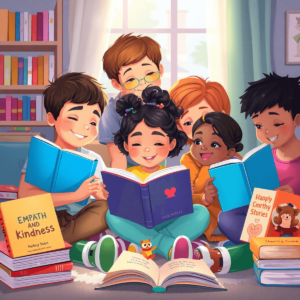
1. Overview of the Value of Math Proficiency in Early Childhood Education
More than simply computations and numbers, mathematics is a basic language for comprehending the world we live in. Early on, developing a constructive and interesting connection with mathematical ideas is essential for both cognitive development and long-term academic achievement. The importance of mathematical literacy is examined in this section, as is how creative teaching strategies may change kids’ attitudes about arithmetic.
A strong foundation in mathematics is essential for cognitive growth and future academic achievement. Children’s long-term learning trajectory may be greatly impacted by their early comprehension and engagement with mathematical topics. Math anxiety and intimidation might result from traditional math instruction’s emphasis on rote memorization and abstract problem-solving. Through the use of storytelling and narrative techniques, teachers may turn math from a potentially daunting topic into an engaging, approachable, and significant educational process.
2. Enhancing Math Education with Storytelling and Narrative
One effective, but sometimes neglected, teaching strategy in mathematics is storytelling. Teachers may bridge the gap between children’s natural learning processes and difficult mathematical concepts by turning abstract number notions into captivating stories. This method uses the innate human love of tales to increase the accessibility, enjoyment, and significance of mathematics learning.
2.1. Advantages of Math Instruction Through Narrative
Traditional arithmetic education sometimes uses repetitious activities and rote memorization, which may make young students anxious and disengaged. A ground-breaking substitute is provided by narrative-based math education, which incorporates mathematical ideas into gripping tales that appeal to kids’ innate curiosity, emotional intelligence, and creativity.
A potent educational strategy for teaching mathematics that transcends traditional teaching techniques is storytelling:
Through the use of familiar scenarios and people, narratives provide students real-world settings that aid in their understanding of mathematical ideas. To make abstract mathematical concepts concrete and relatable, a tale about a baker splitting a cake evenly among friends might be used to explain fraction principles.
Emotional Engagement: Stories help kids develop their emotional intelligence and creativity, which makes studying arithmetic more fun and memorable. Imagine a story in which a character solves a problem by using multiplication, turning an otherwise dull idea into a fascinating journey.
Decreased Math Anxiety: Teachers may lessen the anxiety and tension that are often connected to solving mathematical problems by introducing math via narrative. By demonstrating that math is a tool for creativity and problem-solving rather than a source of fear, narratives humanize mathematical issues.
A Narrative Approach Example: The Counting Adventure
An example of a narrative might center on a character called “Mia the Mathematician” who must use her mathematical abilities to solve practical problems:
In the garden, Mia enjoyed assisting her grandma. She was requested to assist in planting flower seeds by her grandma one bright morning. Her grandma clarified, “A total of 24 seeds must be planted.” “Can you help me divide them equally into 6 rows?”
Through a realistic and captivating context, this straightforward story covers division, counting, and spatial reasoning.
Examining Various Math Storybook Types ## 3.
In literature, mathematics is present in everything from picture books to intricate storylines. Children’s real experiences and abstract mathematical ideas are vitally connected via math storybooks. Through the thoughtful selection and use of various math-themed books, educators and parents may provide rich, immersive learning experiences that make mathematical inquiry enjoyable and thought-provoking.
3.1. Math-Based Picture Books
A novel and visually appealing way to introduce mathematical concepts to young students is via picture books. These books may make difficult mathematical ideas approachable and engaging for kids by demythologizing them with vibrant images, likable characters, and straightforward but deep stories.
Young learners may be introduced to mathematical concepts using picture books in a novel and efficient way:
Counting and Number Recognition Books: These books teach youngsters about fundamental counting, number sequences, and numerical connections via visual narrative.
Stories that use creative characters and situations to integrate form identification, spatial reasoning, and geometric ideas are known as “Geometric Adventure Stories.”
Children are encouraged to think critically and use mathematical reasoning via stories that pose mathematical problems within an interesting storyline. These are known as “problem-solving narratives.”
4. Engaging Exercises and Games to Enhance Math Reading
Mathematics education is an active, dynamic process of inquiry and discovery rather than a passive one. Children may apply, experiment with, and absorb mathematical ideas via play, creativity, and collaborative learning thanks to interactive activities and games, which provide crucial hands-on experiences that enhance mathematical storytelling.
4.1. Including Interactive Activities
There must be a balance between theoretical knowledge and real-world application. The gap between story-based mathematical principles and practical problem-solving abilities is filled by hands-on exercises. Through the creation of captivating, narrative-based interactive experiences, teachers may assist kids in gaining a comprehensive and intuitive grasp of mathematical concepts.
Adding interactive experiences to mathematics storybooks improves learning and memory:
Story-Based Math Games ####
- The Pizza Party Game Fraction
Drawing from a novel about a pizza place, kids use colored paper and paper plates to: * Separate “pizzas” into equal halves
Practice understanding fractions and gain knowledge about equitable allocation and sharing.
Treasure Hunt for Measurements
measuring of things in the classroom, producing their own treasure maps with measured distances, and using both standard and non-standard measuring instruments are some of the activities that are inspired by a pirate narrative and map-building.
Using Role-Playing Games
Children enact a narrative about grocery shopping in The Shopping Adventure. To practice, use play money:
The addition, subtraction, and basic budgeting
Counting and recognizing currencies
Artistic Projects
Firstly, the Geometry Shape Monsters
Construct creatures out of geometric shapes.
Gain knowledge of: * Shape recognition * Symmetry * Spatial thinking
- Number Line Landscape – Sketch a picturesque scene in which: * Trees stand for rising numbers; * Rocks for falling numbers; * Bridges link ideas in mathematics
5. Conclusion: Using Inspiring Literature to Encourage a Passion for Mathematics
A style of thinking and comprehending the world, mathematics is more than simply a topic to be taught. We may develop mathematical thinkers who are inquisitive, self-assured, and imaginative and who see ideas and numbers as instruments for investigation and problem-solving by rethinking mathematical education via narrative.
Teachers and parents may support children’s development of solid mathematical foundations while fostering their creativity, critical thinking, and problem-solving abilities by using narrative tactics, interactive exercises, and captivating storybooks.
6. Applying Narrative in Math Instruction: Useful Techniques
6.1. Curriculum Development and Training for Teachers
Effective narrative integration in math classes requires a thorough approach to curriculum design and professional development. To properly turn mathematical ideas into captivating stories, educators need certain training:
Important Training Elements: – Methods for telling tales with a lot of mathematical detail
Strategies for creating narrative-based learning experiences; techniques for choosing and modifying suitable math storybooks
Recognizing the psychological effects of narrative on learning mathematics
Applications for Curriculum Development: – Develop adaptable lesson plans that include narrative components
Create detailed instructions that connect storytelling techniques to certain learning goals in mathematics.
Work together to develop specialized math materials with children’s book writers and artists.-centered children’s books
6.2. Involvement of Parents and Home Education
Parents are essential in promoting mathematics literacy by using storytelling:
Resources to Help Families:
Reading lists of math-focused picture books that have been carefully chosen; guided worksheets for at-home learning
Workshops outlining the use of storytelling in teaching mathematics; resources to help parents and kids tell mathematical tales
The following are some ideas for Family Math Night: Interactive storytelling sessions
Working together to solve mathematical problems
- Math game evenings based on stories
Together, they share and produce mathematical tales.
Techniques for Classroom Implementation ### 6.3
Realistic techniques for enhancing mathematics narratives:
Frameworks for Telling Stories: 1. Interpretation of the Narrative Problem
A captivating tale that poses a mathematical problem should be told first.
For instance, a story about allocating resources or resolving a neighborhood issue
- Interactive Problem Solving – Lead pupils through mathematical reasoning in the context of the narrative
Promote innovative methods for resolving issues.
- Create many avenues for solutions
Classroom Materials: – A special “Math Story Corner” – Online resources for storytelling
Interactive software for math storybooks
Multimedia platforms for storytelling
6.4. Methods of Evaluation and Assessment
Rethinking mathematical evaluation using storytelling techniques:
Creative Methods of Evaluation:
Use narrative to assess mathematics comprehension and gauge innovative problem-solving abilities.
Monitor students’ emotional reactions and level of involvement with mathematics learning. Create research initiatives to examine the long-term effects of narrative-based instruction.
6.5. Dealing with Implementation Issues
Potential roadblocks and all-encompassing fixes:
Common Difficulties: 1. Reluctance of Teachers
Establish comprehensive initiatives for professional growth and mentoring.
Create thorough instructional materials.
Make sure that narrative techniques satisfy defined learning goals by using Curriculum Alignment.
Develop adaptable lesson plans.
Create precise guidelines for congruence with academic norms.
- Diverse Learning Needs – Develop approaches for adaptable storytelling
Create storylines that are inclusive and reflect a range of backgrounds.
Create experiences for learning that are multimodal.
6.6. Suggested Sources
Specialized courses in mathematical storytelling and online training programs are two examples of professional development.
Collaborative networks of educators
Research articles on learning via storytelling
Study Resources: – Collections of extensive math storybooks
Curriculum guidelines for storytelling; interactive online resources for education
Frameworks for assessments in narrative-based education
7. Concluding Remarks: Revolutionizing Mathematics Education
Stories are a potent tool for teaching mathematics because they turn difficult ideas into interesting, approachable lessons. Teachers and parents may use narrative strategies to: – Reduce math anxiety – Improve mathematical comprehension – Develop creative problem-solving abilities – Encourage a lifetime love of mathematical thinking
Future Paths
Conduct further study on teaching mathematics using narratives; create more complex storytelling resources.
Develop varied, inclusive mathematics narratives.
- Increase possibilities for professional development
Call to Action: Adopt storytelling as an essential component of mathematical literacy given its capacity to uplift, inform, and empower young students.


